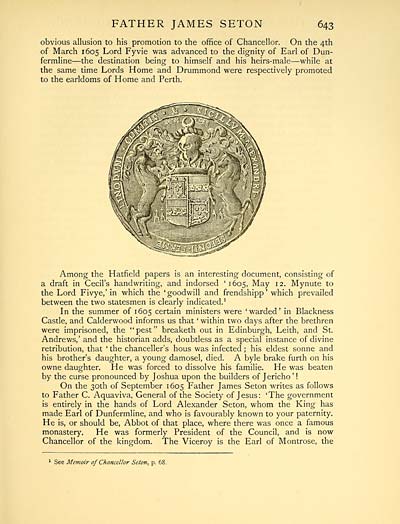Download files
Complete book:
Individual page:
Thumbnail gallery: Grid view | List view

FATHER JAMES SETON
643
obvious allusion to his promotion to the office of Chancellor. On the 4th
of March 1605 Lord Fyvie was advanced to the dignity of Earl of Dun-
fermline — the destination being to himself and his heirs-male — while at
the same time Lords Home and Drummond were respectively promoted
to the earldoms of Home and Perth.
Among the Hatfield papers is an interesting document, consisting of
a draft in Cecil's handwriting, and indorsed '1605, May 12. Mynute to
the Lord Fivye,' in which the 'goodwill and frendshipp' which prevailed
between the two statesmen is clearly indicated. 1
In the summer of 1605 certain ministers were 'warded' in Blackness
Castle, and Calderwood informs us that ' within two days after the brethren
were imprisoned, the "pest" breaketh out in Edinburgh, Leith, and St.
Andrews,' and the historian adds, doubtless as a special instance of divine
retribution, that ' the chanceller's hous was infected ; his eldest sonne and
his brother's daughter, a young damosel, died. A byle brake furth on his
owne daughter. He was forced to dissolve his familie. He was beaten
by the curse pronounced by Joshua upon the builders of Jericho' !
On the 30th of September 1605 Father James Seton writes as follows
to Father C. Aquaviva, General of the Society of Jesus: 'The government
is entirely in the hands of Lord Alexander Seton, whom the King has
made Earl of Dunfermline, and who is favourably known to your paternity.
He is, or should be, Abbot of that place, where there was once a famous
monastery. He was formerly President of the Council, and is now
Chancellor of the kingdom. The Viceroy is the Earl of Montrose, the
1 See Memoir of Chancellor Seton, p. 68.
643
obvious allusion to his promotion to the office of Chancellor. On the 4th
of March 1605 Lord Fyvie was advanced to the dignity of Earl of Dun-
fermline — the destination being to himself and his heirs-male — while at
the same time Lords Home and Drummond were respectively promoted
to the earldoms of Home and Perth.
Among the Hatfield papers is an interesting document, consisting of
a draft in Cecil's handwriting, and indorsed '1605, May 12. Mynute to
the Lord Fivye,' in which the 'goodwill and frendshipp' which prevailed
between the two statesmen is clearly indicated. 1
In the summer of 1605 certain ministers were 'warded' in Blackness
Castle, and Calderwood informs us that ' within two days after the brethren
were imprisoned, the "pest" breaketh out in Edinburgh, Leith, and St.
Andrews,' and the historian adds, doubtless as a special instance of divine
retribution, that ' the chanceller's hous was infected ; his eldest sonne and
his brother's daughter, a young damosel, died. A byle brake furth on his
owne daughter. He was forced to dissolve his familie. He was beaten
by the curse pronounced by Joshua upon the builders of Jericho' !
On the 30th of September 1605 Father James Seton writes as follows
to Father C. Aquaviva, General of the Society of Jesus: 'The government
is entirely in the hands of Lord Alexander Seton, whom the King has
made Earl of Dunfermline, and who is favourably known to your paternity.
He is, or should be, Abbot of that place, where there was once a famous
monastery. He was formerly President of the Council, and is now
Chancellor of the kingdom. The Viceroy is the Earl of Montrose, the
1 See Memoir of Chancellor Seton, p. 68.
Set display mode to:
![]() Universal Viewer |
Universal Viewer | ![]() Mirador |
Large image | Transcription
Mirador |
Large image | Transcription
Images and transcriptions on this page, including medium image downloads, may be used under the Creative Commons Attribution 4.0 International Licence unless otherwise stated. ![]()
| Histories of Scottish families > History of the family of Seton during eight centuries > Volume 2 > (79) |
|---|
| Permanent URL | https://digital.nls.uk/96847770 |
|---|
| Attribution and copyright: |
|
|---|---|
| Description | A selection of almost 400 printed items relating to the history of Scottish families, mostly dating from the 19th and early 20th centuries. Includes memoirs, genealogies and clan histories, with a few produced by emigrant families. The earliest family history goes back to AD 916. |
|---|

